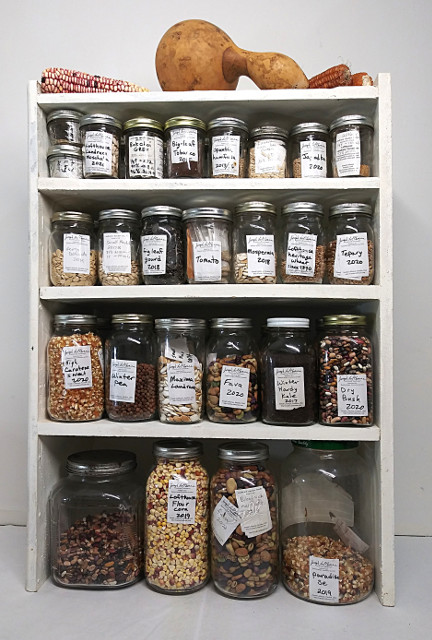
 4
4




 9
9




It's never too late to start gardening, and even the smallest project is worthwhile.
 12
12




Invasive plants are Earth's way of insisting we notice her medicines. Stephen Herrod Buhner
Everyone learns what works by learning what doesn't work. Stephen Herrod Buhner
 4
4




 12
12




“There are no words to express the abyss between isolation and having one ally. It may be conceded to the mathematician that four is twice two. But two is not twice one; two is two thousand times one.”
― G. K. Chesterton
 10
10




Real funny, Scotty, now beam down my clothes!
 3
3




 2
2




Malek Beitinjan wrote:I've taken the somewhat lazy approach to seed saving. Everytime I eat something, I pull the seeds out and go throw it in some dirt somewhere.
Determining the difference between Bockings 4 and 14 is done by consensus. It's like trying to identify the difference between twins.
"There are other spots on the web to get my fix proving someone is an idiot but no other place for what I get here." -- former permie Brice Moss, 2012.
 4
4




I like to grow and ferment and frolic about and play.
 7
7




"... And being swept along is not enough." R.M. Rilke

 12
12




Marie Abell wrote:The great thing about landrace breeding is that you don't have to freak out about cross-pollination or seed-labeling. At least, I don't 😜
 6
6




 3
3




 3
3




 4
4




Forever creating a permaculture paradise!
 5
5




The "miles for pollination," in my opinion, is another myth made up by those selling seeds. For squash or beans it's something like 30 feet. I really don't pay that much attention. If you really want to keep your cabbage clean of broccoli genes, plant one for seed in 2020 and the other in 2021. If you harvest the broccoli before it goes to seed, you can plant the cabbage right next to it and let the cabbage go to seed without a problem.Michael Dotson wrote:Homestead farmers won't have an issue with pollination, except almost everyone in rural America has a garden and spacing between gardens in my area rarely exceeds the miles required for isolation. It's kind of a crap shoot... So, that begs the question, do I continue to save seeds hoping my heirloom Sweet Corn isn't cross pollinated with a local hybrid and it's either sterile or something weird comes up, or do I buy seeds from Walmart?
New location. Zone 6b, acid soil, 30+ inches of water per year.
https://growingmodernlandraces.thinkific.com/?ref=b1de16
Growingmodernlandraces.com affiliate
 3
3




Lauren Ritz wrote:The "miles for pollination," in my opinion, is another myth made up by those selling seeds.
 3
3




New location. Zone 6b, acid soil, 30+ inches of water per year.
https://growingmodernlandraces.thinkific.com/?ref=b1de16
Growingmodernlandraces.com affiliate




“We can complain because rose bushes have thorns, or rejoice because thorn bushes have roses.” — Abraham Lincoln
 4
4




New location. Zone 6b, acid soil, 30+ inches of water per year.
https://growingmodernlandraces.thinkific.com/?ref=b1de16
Growingmodernlandraces.com affiliate





 3
3




Debbie Ang wrote:I would like to start a landrace of winter squash. I am wondering how many seeds to plant out. Do you plant more densely than usually recommended, then select against weak plants? Do you make a point of planting out equal numbers of seeds from each fruit? Or just mix and plant out as many as you have room for? Thanks.

 6
6




Jen Fulkerson wrote:What do you save your seeds in. Paper envelope, glass jar, cloth bag? Does it matter? I know some need to be in the fridge, but some don't. Anyone know of a good list of where which seeds should be saved? Thanks

 4
4




"... And being swept along is not enough." R.M. Rilke
 2
2




"... And being swept along is not enough." R.M. Rilke





 3
3




Marie Abell wrote:Also, can we just appreciate how Joseph's seed storage is so beautiful it could be an art exhibit 😍😍😍
 1
1




Joseph Lofthouse wrote:
Marie Abell wrote:Also, can we just appreciate how Joseph's seed storage is so beautiful it could be an art exhibit 😍😍😍
I spent an entire day preparing to take that photo, AS A WORK OF ART, specifically for the book.
That really is the shelf that I custom built to store my seeds on. I moved it out of the dark corner into a bright spot, dusted. Redid labels, etc...
"... And being swept along is not enough." R.M. Rilke
 4
4





 6
6





|
He got surgery to replace his foot with a pig. He said it was because of this tiny ad:
The new kickstarter is now live!
https://www.kickstarter.com/projects/paulwheaton/garden-cards
|






